Technical Data Cable Carriers (CABLEVEYOR) - Examples of cable carrier installations
Standard arrangement
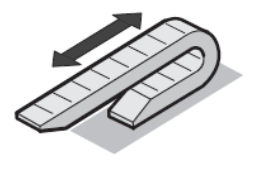

Support roller arrangement
■Applicable to TK Series/TKH Series/TKS Series/TKP Series/TKR Series/TKQ Series/TKMK Series/TKMT Series/TKC Series (Travel speed 150 m/min or less)
※Also applicable to TKUA type. Please contact us for consideration.
■For a support roller in one location (S1: travel length): The allowable travel length is 1.5-times of the travel length with no support roller (except the TKR Series*).

■For support rollers in two locations (S2: travel length): The allowable travel length is 2-times of the travel length with no support roller (except the TKR Series*).

Note) The installation distance between support rollers (L) for the TKR Series is as follows.
- TKR15H22:L=0.35m below
- TKR20H28:L=0.7m below
- TKR26H40:L=0.7m below
- TKR28H52:L=0.9m below
Note) Three or more support rollers may be required depending on the travel length.
With support plates
■Applicable to TKC Series (Travel speed 60 m/min or less) Contact a Tsubaki representative when considering cable carriers other than TKC Series.
(S2: travel length): The allowable travel length is 2-times of the travel length with no support plate.

Note) When support rollers or support plates are added, the moving end bracket cannot be used in an inside mounting. (Because the moving end bracket will interfere with the rollers and plates.)
Gliding arrangement
■Applicable to the TKP Series/TKC Series/TKMK Series/TKMT Series
※Also applicable to TKUA type. Please contact us for consideration.

| Features | A special installation method used with a long length that exceed the load diagram with support rollers in 2 locations. The moving end bracket is made to order and differs from the standard part in general. The mounting height of the moving end differs from the standard mounting height. |
|---|---|
| Travel length | Refer to the gliding arrangement |
| Additional mass | |
| Travel speed | |
| Guide method | A rail with step is required to guide a cable carrier that sags when it runs. The gaps to the left and right of the cable carrier and guide channels must be narrower than the standard installation. |
Horizontal-vertical combined arrangement
■Applicable to all models
※Be careful with the length so that an excessive force is not applied to the cable carrier.
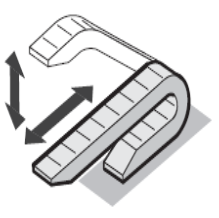
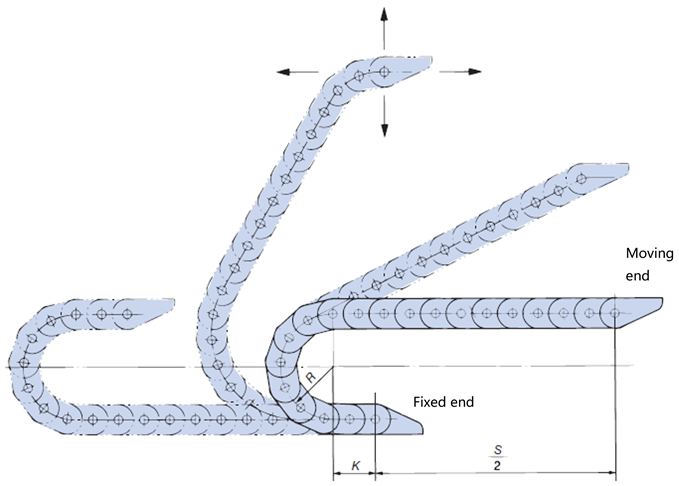
| Features |
|
|---|---|
| Travel length | Same as standard arrangement (However, support rollers cannot be used. ) |
| Additional mass | Same as standard arrangement |
| Travel speed | |
| Guide method | |
| Note | The length of the cable carrier is longer than the standard installation. Decide on the length by taking into consideration the sloping section. In particular, be careful of the leeway length when the cable carrier moves back. |
Vertical arrangement
■Applicable to all models except TKS Series
・Use this arrangement when the cable carrier moves in the vertical (up/down) direction.
・Guide channels are required on both sides to prevent the cable carrier from swaying or collapsing.
■Vertical arrangement (standing)
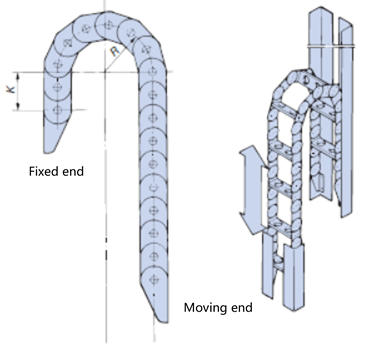
| Features |
・An installation method in which the cable carrier is made to stand up. ・Not suited to long travel lengths because the mass of the cables and hoses is concentrated at the top of the bending radius. |
|---|---|
| Travel length | Same as standard arrangement |
| Additional mass | Contact us for more information. |
| Travel speed | Same as standard arrangement |
| Guide method |
|
| Note |
|
■Vertical arrangement (hanging)

| Features |
An installation method in which the cable carrier is hanging. The load on the cable carrier becomes a tensile load so the load diagram cannot be used. Refer to the vertical arrangement (hanging) types table. |
|---|---|
| Travel length | Refer to the following table. |
| Additional mass | |
| Travel speed | Same as standard arrangement |
| Guide method |
|
| Note |
・TK Series and TKH Series use made-to-order pins to lessen pretension in the unsupported length section. ・The stay dimension (height) may be larger than standard for the TK Series and TKH Series. |
| Size | Maximum travel length m |
Maximum additional mass kg/m |
Maximum travel speed m/min |
Size | Maximum travel length m |
Maximum additional mass kg/m |
Maximum travel speed m/min |
Size | Maximum travel length m |
Maximum additional mass kg/m |
Maximum travel speed m/min |
||
|---|---|---|---|---|---|---|---|---|---|---|---|---|---|
| TKP13H10 | 6 | 0.6 | 300 | TKR20H28 | 9 | 2 | 300 | TK070 | 8 | 15 | 60 | ||
| TKP18H14 | 7 | 1 | 300 | TKC34H25 | 8.5 | 5 | 300 | TK095 | 7 | 30 | 60 | ||
| TKP18H15 | 7 | 1 | 300 | TKC47H36 | 11 | 8 | 300 | TK130 | 9 | 50 | 60 | ||
| TKP25H15 | 5.5 | 1 | 300 | TKC64H50 | 9 | 16 | 300 | TK180 | 11.5 | 50 | 60 | ||
| TKP35H22 | 5 | 2 | 300 | TKC85H68 | 4.5 | 35 | 300 | TKH250 | 87 | 50 | 60 | ||
| TKP45H25 | 14 | 4 | 300 | TKC91H56 | 9 | 16 | 300 | ||||||
| TKP58H39 | 10 | 6 | 300 | TKC91H80 | 10.5 | 40 | 300 | ||||||
| TKP62H34 | 5 | 7.5 | 300 | TKMK47H28 | 4.5 | 6 | 300 | ||||||
| TKP68H46 | 10 | 6 | 300 | TKMK65H42 | 17 | 15 | 300 | ||||||
| TKP90H50 | 7 | 16 | 300 | TKMK95H58 | 8.5 | 40 | 300 | ||||||
| TKP125H74 | 5.5 | 22 | 300 | TKMK125H72 | 10 | 40 | 300 | ||||||
| TKP91H56 | 9 | 16 | 300 | ||||||||||
| TKP91H80 | 11 | 40 | 300 |
Note) When fixed end is at the center of the travel length.
Note) Excluding MW Type. (Contact a Tsubaki representative regarding usage with MW Type.)
Top-fixed arrangement (bottom movement)
■Applicable to all models
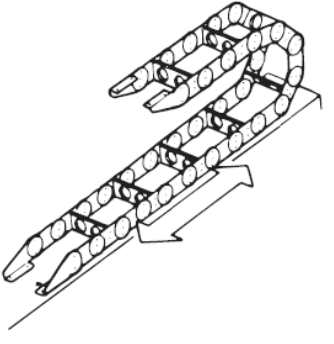
| Features | The arrangement has the moving end on the bottom, which is the reverse of the standard arrangement. |
|---|---|
| Travel length | Same as standard arrangement |
| Additional mass | |
| Travel speed | |
| Guide method |
|
| Note | TK Series, TKS Series, and TKH Series use made-to-order pins to lessen pretension in the unsupported length section. |
Side mount arrangement
■Applicable to TK Series/TKP Series/TKC Series/TKMK Series/TKMT Series/TKUA Series
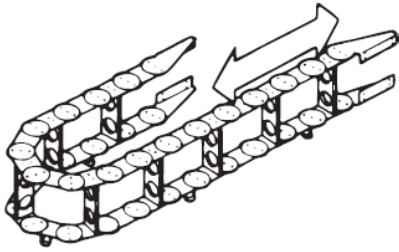
| Features | The cable carrier is used on its side. This arrangement is suitable for when the connection surface for the steel brackets is lateral, when the travel length is long, and when there are space restrictions in the height direction. |
|---|---|
| Travel length | Refer to the following table. |
| Additional mass | |
| Travel speed | |
| Guide method |
|
| Note | TK Series and TKH Series use made-to-order pins to lessen pretension in the unsupported length section. |
| Size | Maximum travel length m |
Maximum additional mass kg/m |
Maximum travel speed m/min |
Size | Maximum travel length m |
Maximum additional mass kg/m |
Maximum travel speed m/min |
Size | Maximum travel length m |
Maximum additional mass kg/m |
Maximum travel speed m/min |
||
|---|---|---|---|---|---|---|---|---|---|---|---|---|---|
| TKP13H10 | 13 | 0.6 | 60 | TKP91H56 | 45 | 4 | 60 | TKMK47H28 | 18 | 2 | 60 | ||
| TKP18H14 | 15 | 1 | 60 | TKP91H80 | 64 | 8 | 60 | TKMT47H26 | 18 | 2 | 60 | ||
| TKP18H15 | 15 | 1 | 60 | TKC34H25 | 31 | 2 | 60 | TKMK65H42 | 94 | 4 | 60 | ||
| TKP25H15 | 11 | 1 | 60 | TKC47H36 | 43 | 3 | 60 | TKMT65H38 | 94 | 4 | 60 | ||
| TKP35H22 | 11 | 2 | 60 | TKC64H50 | 45 | 4 | 60 | TKMK95H58 | 71 | 6 | 60 | ||
| TKP45H25 | 48 | 2 | 60 | TKC85H68 | 31 | 6 | 60 | TKMT95H54 | 71 | 6 | 60 | ||
| TKP58H39 | 34 | 3 | 60 | TKC91H56 | 45 | 4 | 60 | TKMK125H72 | 73 | 8 | 60 | ||
| TKP62H34 | 21 | 3 | 60 | TKC91H80 | 56 | 8 | 60 | TKMT125H68 | 73 | 8 | 60 | ||
| TKP68H46 | 34 | 3 | 60 | TK070 | 30 | 14 | 30 | ||||||
| TKP90H50 | 42 | 4 | 60 | TK095 | 30 | 18 | 30 | ||||||
| TKP125H74 | 30 | 6 | 60 | TK130 | 60 | 24 | 30 | ||||||
| TK180 | 80 | 26 | 30 | ||||||||||
| TKH250 | 100 | 44 | 30 |
Note) Excluding MW Type. (Contact a Tsubaki representative regarding usage with MW Type.)
Horizontal circular travel arrangement
■Applicable to TK Series/TKP Series/TKC Series (Partial)
※Also applicable to TKUA type. Please contact us for consideration.
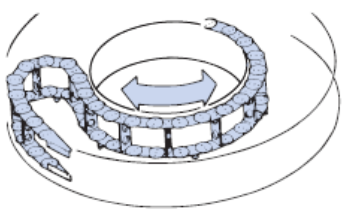
| Features |
|
|---|---|
| Maximum rotation angle | Approximately 360°(The maximum rotation angle may be larger or smaller depending on the conditions.) |
| Additional mass | Refer to the side mount arrangement table. |
| Travel speed | 30m/min below |
| Guide method |
|
Horizontal circular travel arrangement
■Applicable to TK Series/TKP Series
※Also applicable to TKUA type. Please contact us for consideration.
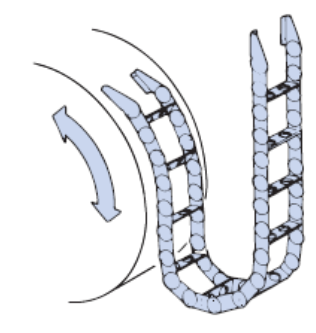
| Features |
|
|---|---|
| Maximum rotation angle | 180°~200°(The maximum rotation angle may be greater depending on the conditions. ) |
| Additional mass | Refer to the vertical arrangement (hanging) types table. |
| Travel speed | 60m/min below |
| Guide method |
|
Hanging with support bolts
■Applicable to TK Series
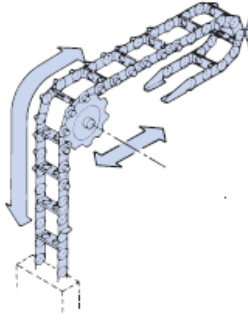
| Features |
|
|---|---|
| Travel length | The unsupported length is within the load diagram. |
| Additional mass | Within the load diagram. |
| Travel speed | 60m/min below |
| Guide method | Sprockets are required. |
| Note | The stay dimension (height) may need to be larger than standard. |
Horizontal-vertical combined arrangement
■Applicable to TK Series (Excluding the TK070)

| Features |
|
|---|---|
| Travel length | ・TK180 50m below ・TK130 42m below ・TK095 24m below ・And approximately 4-times or less of standard within the load diagram. |
| Additional mass | Within the load diagram. |
| Travel speed | 30m/min below |
| Guide method | Guide channels matched to the height of the cable carrier are required. Cut out positions where the side rollers go down. |
Traveling roller type
■Applicable to TK Series (TK095, TK130, TK180 (R300 and higher))

| Features |
|
|---|---|
| Travel length | Same as support rollers in 2 locations in the catalog (cannot be larger than that). |
| Additional mass | Within the load diagram. |
| Travel speed | 30m/min below |
| Guide method | Guide channels for running are required. |
Nested arrangement
■Applicable to TK Series/TKH Series/TKP Series/TKC Series/TKMK Series/TKMT Series/TKUA Series

| Features |
|
|---|---|
| Travel length | Same as standard arrangement However, support rollers cannot normally be used. |
| Additional mass | Within the load diagram. |
| Travel speed | Same as standard arrangement |
| Guide method |
|
| Note | It is difficult to install support rollers for the outer cable carrier. |

